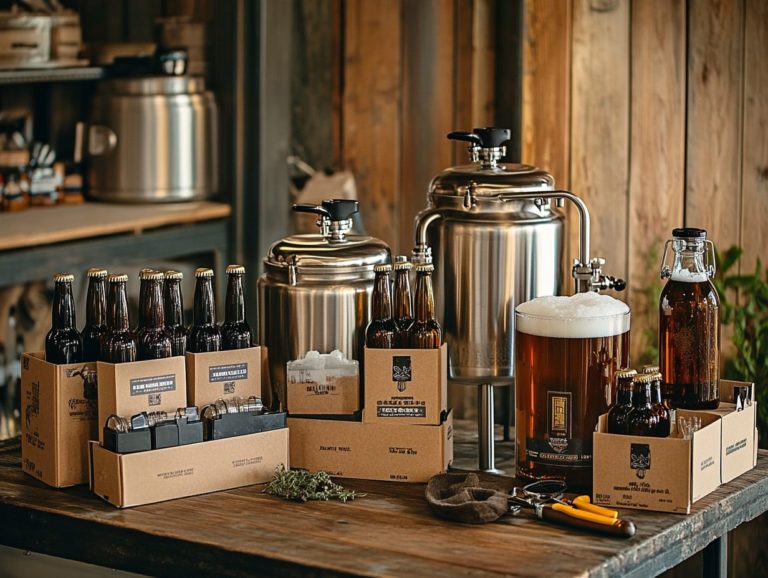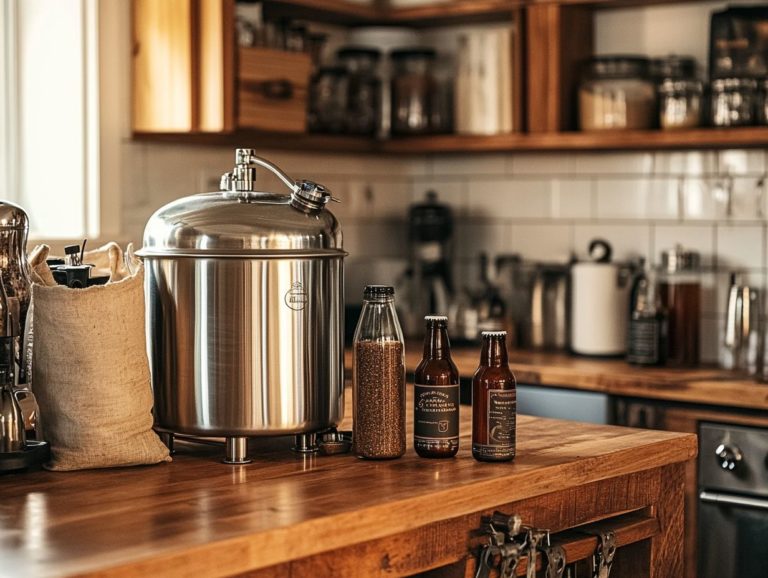The Importance of Sanitization in Brewing
Contents
- The Importance of Sanitization in Brewing
- Why Is Sanitization Important in Brewing?
- What Are the Different Methods of Sanitization?
- What Are the Common Mistakes in Sanitization?
- How Often Should Sanitization Be Performed?
- 2. After Each Use
- 3. Regularly During Brewing Process
- Frequently Asked Questions
- What is the importance of sanitization in brewing?
- What are the consequences of not properly sanitizing brewing equipment?
- How does sanitization impact the taste of beer?
- Is sanitization important for both homebrewing and commercial brewing?
- What are some common sanitization methods used in brewing?
- How often should brewing equipment be sanitized?
The Importance of Sanitization in Brewing
Sanitization is a crucial aspect of brewing that often slips under the radar. It plays a vital role in achieving the high-quality beer you desire.
Proper sanitizing and cleaning of equipment ensure that no harmful microorganisms affect your brew. Preventing contamination is key for maintaining consistency in flavor and promoting safety. Effective sanitization becomes essential for both homebrewing enthusiasts and commercial operations alike.
Let s explore effective methods of sanitization that can elevate your brewing game! This article delves into various methods of sanitization, sheds light on common missteps that could undermine your efforts, and offers expert guidance on the optimal frequency for sanitizing throughout the brewing process, including the use of chemical sanitizers like Star San and Iodophor.
Uncover the reasons why proper sanitization is the cornerstone of brewing excellence, ensuring your brewing equipment remains free of contamination and your beer maintains its intended flavor profile.
Key Takeaways:
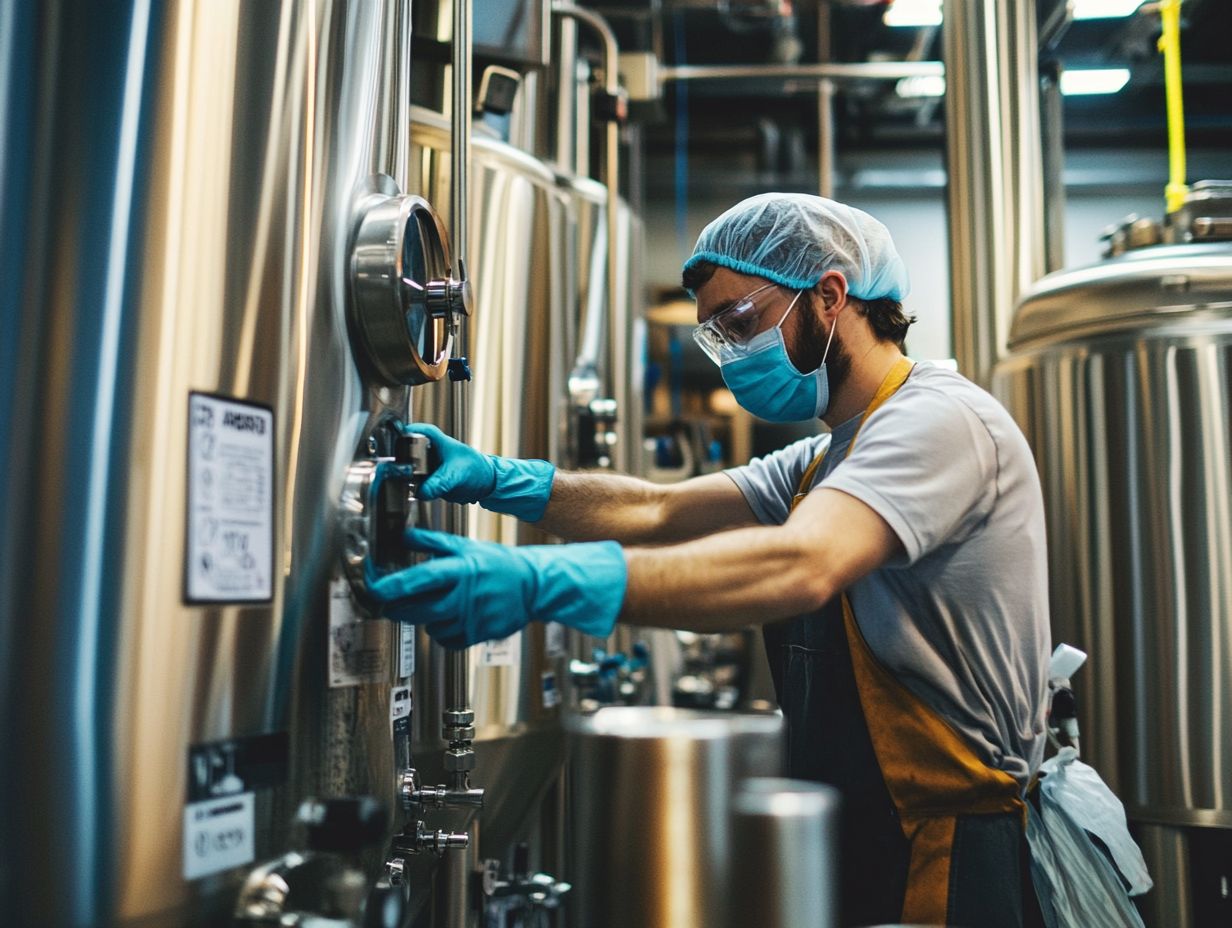
- Proper sanitization prevents contamination and ensures consistent flavor in brewing.
- Chemical, heat, and UV sanitization methods, including the use of iodine-based sanitizers, are commonly used in the brewing industry.
- Common mistakes in sanitization include not cleaning before sanitizing, not using adequate chemical sanitizers, and not allowing enough contact time.
Why Is Sanitization Important in Brewing?
Sanitization is a cornerstone of the brewing process, profoundly influencing the quality of the beer you produce. Ensuring that your brewing equipment is free from harmful microorganisms is essential, as contamination can easily spoil your hard work.
In the intricate dance of brewing, where good bacteria and yeast play pivotal roles in fermentation, maintaining cleanliness is paramount. You want to prevent the growth of bad bacteria and other microorganisms that can compromise both flavor and safety. This creates a stable environment conducive to proper fermentation and wort processing.
Ultimately, by implementing effective sanitization practices, you safeguard the integrity of your brewing process and the final product an absolute necessity for both homebrewing enthusiasts and professional breweries alike, including renowned names like MobCraft Beer Inc. and experts like Dave Carpenter.
1. Prevents Contamination
Preventing contamination is one of the primary reasons you should implement strict sanitization practices during the brewing process. Any presence of unwanted microorganisms can adversely affect the quality and safety of the beer you produce.
These microorganisms can include wild yeast, bacteria, and molds, all of which pose serious threats to your brewing endeavors. Wild yeast can introduce unexpected flavors, while bacteria might bring sourness or off-aromas that ultimately compromise your carefully crafted taste profile.
Molds can lead to physical contamination and spoilage, underscoring the importance of maintaining a hygienic environment for your brewing operations. To combat these issues, effective use of both chemical and heat sanitizers, such as acid-based sanitizers and heat sanitation methods, is essential in eliminating contaminants.
When employed correctly, chemical sanitizers can swiftly eradicate various pathogens, while heat sanitization ensures that your equipment remains free from persistent microorganisms. Neglecting thorough sanitization practices risks batch spoilage, financial losses, and a tarnished reputation that can take years to rebuild.
2. Ensures Consistency in Flavor
Ensuring consistency in flavor is paramount for any brewing operation. Effective cleaning practices are your best allies in achieving this goal. A controlled environment fosters proper fermentation and minimizes taste variations.
Sanitization is not just a step in the process; it plays a crucial role in shaping fermentation. It allows desirable yeast and beneficial bacteria to thrive while keeping unwanted contaminants at bay. This balance is essential for developing distinct flavor profiles and achieving the desired outcomes in your final product.
Impurities can introduce off-flavors and unwelcome aromas, ultimately undermining the beer’s character and consistency. This can affect both the overall quality and drinkability of your brew. Therefore, maintaining a sharp focus on sanitation is vital for your success.
3. Promotes Safety
Promoting safety in brewing is absolutely essential. The presence of harmful microorganisms can lead to foodborne illnesses and unsafe products. The role of sanitization in the brewing process is critically important.
The potential health risks tied to inadequate sanitization are significant. They can jeopardize both the quality of your brew and the well-being of your consumers. Pathogens like wild yeast, bacteria, and mold can flourish in unsanitary conditions, leading to contamination that alters flavor profiles and creates hazardous drinking experiences.
Don t compromise on sanitization; it s crucial for your safety and the quality of your brew! By adhering to strict sanitation practices, you can effectively mitigate these risks and ensure that your products are safe for consumption. Utilizing effective sanitizers and maintaining a pristine brewing environment is vital to preventing the spread of harmful microorganisms.
What Are the Different Methods of Sanitization?
In brewing, you have various sanitization methods available to guarantee that your equipment and surfaces remain free from harmful microorganisms. These methods include chemical sanitizers, heat sanitation, acid-based sanitizers, and UV sanitization. Each offers unique advantages and applications throughout the brewing process.
By selecting the appropriate method, you can ensure the integrity of your brew and enhance the overall quality of your final product. Always remember that proper sanitation can prevent common brewing issues like contamination from Acetobacter, which can spoil your beer by producing unwanted acids.
1. Chemical Sanitization
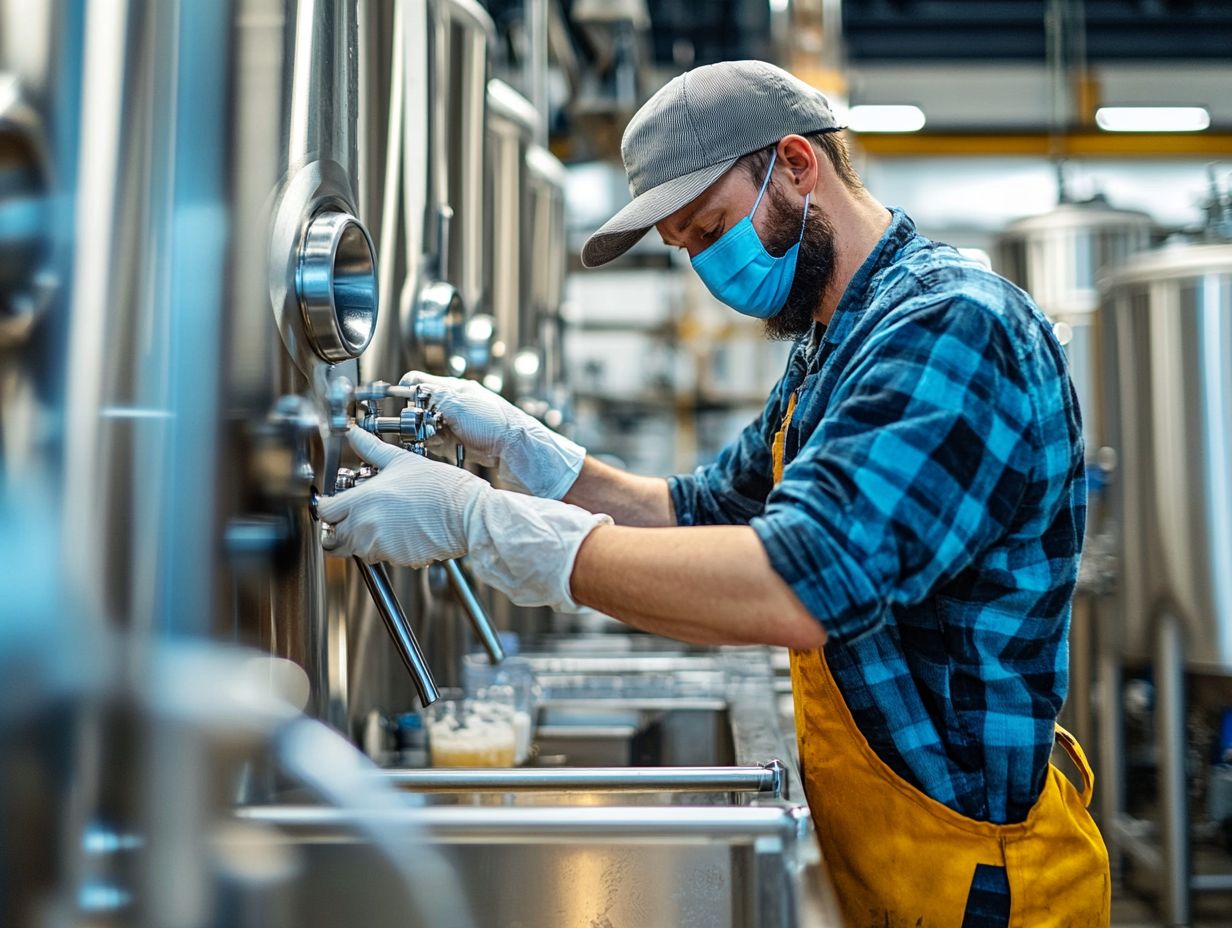
Chemical sanitization is a cornerstone method in brewing. It employs substances like Star San, Iodophor, and Powdered Brewery Wash (PBW) to effectively eradicate harmful microorganisms from your brewing equipment and surfaces.
This method is vital for preserving the integrity of your brewing process. It guarantees that the final product remains free from contamination. Chemical sanitizers disrupt the cellular structure of bacteria, yeast, and mold, rendering them incapable of reproducing and surviving in your brewing environment.
By utilizing the appropriate sanitizing products, you not only protect the quality of your brew but also enhance the overall efficiency of the brewing process. It’s essential to follow the manufacturer’s instructions meticulously to achieve the best possible outcomes. Each product comes with specific dilution ratios and contact times that must be adhered to.
For instance, Star San is a no-rinse sanitizer, making it incredibly convenient for your needs. Meanwhile, PBW excels at removing residues and can be used in tandem to ensure your equipment is thoroughly cleaned before the sanitization process. OxiClean and Bleach are also popular choices among brewers for their effectiveness and ease of use.
2. Heat Sanitization
Heat sanitization is your go-to method for keeping brewing equipment spotless. It employs high temperatures to remove microorganisms. This technique relies on the principle that most harmful bacteria and contaminants simply can t withstand extreme heat, which is crucial for preserving the quality of your brew.
Unlike chemical sanitization methods that may leave behind pesky residues affecting flavor, heat treatments leverage the natural properties of heat. This adds an extra layer of safety and purity to your process. Utilizing tools like immersion wort chillers can further ensure that your wort cools rapidly while maintaining sanitary conditions.
In the brewing industry, where cleanliness is non-negotiable for producing consistent, high-quality beer, the effectiveness of heat sanitization is evident. This is especially true when using tools like immersion wort chillers, which are critical to the cooling process. By applying heat effectively to these devices, you can ensure that all microbial life is eliminated, resulting in a cleaner and more flavorful final product.
Adhering to Good Manufacturing Practices (GMP) further enhances the quality and safety of your brew.
To get the most out of heat sanitization, start by thoroughly cleaning your equipment to remove any debris. Next, heat the metal parts to boiling point for a specified duration to guarantee complete sterilization. Remember to let the equipment cool naturally instead of rinsing it with cold water. This is important because thermal shock can invite contaminants.
Heat sanitization not only safeguards the integrity of your brewing process but also maintains the safety standards every brewer holds dear.
3. UV Sanitization
UV sanitization harnesses the power of ultraviolet light to eliminate microorganisms. This innovative method enhances equipment cleanliness and safety. It offers a chemical-free alternative that ensures the purity of your beer, much like how probiotics in yogurt promote beneficial bacteria without harmful additives.
This process works by disrupting the DNA of bacteria, viruses, and other pathogens, effectively rendering them incapable of reproduction and infection. One significant advantage of UV sanitization is that it avoids introducing any chemicals into the brewing environment, thus preserving the taste and quality of your final product.
However, it s important to be aware of its limitations. The effectiveness of UV light can fluctuate based on factors such as intensity, exposure duration, and the presence of particulates that may shield some microorganisms. Compared to traditional sanitization methods like chemical cleaning or heat, UV offers a modern solution that many brewers prefer. It provides a safe and efficient way to uphold hygienic standards while ensuring the purity of their craft.
What Are the Common Mistakes in Sanitization?
In the brewing process, common mistakes in sanitization can greatly jeopardize the quality and safety of your final product. These issues often arise from misunderstandings about effective cleaning and sanitization practices, such as using products like Star San or Iodophor correctly.
1. Not Cleaning Before Sanitizing
One of the most significant mistakes you can make in the brewing process is neglecting to clean your equipment before applying sanitizers like Star San or Iodophor. This oversight can lead to ineffective sanitation and potential contamination. It highlights the critical importance of cleaning as the foundational step that should precede any sanitization efforts.
Residues like yeast, hops, or even mineral deposits can create a barrier that prevents sanitizers from effectively reaching and treating surfaces, significantly diminishing their intended efficacy.
To ensure a successful cleaning process, consider using warm water combined with the right detergents such as PBW (Powdered Brewery Wash) or OxiClean to loosen and remove those stubborn residues. Afterward, a thorough rinsing is essential to eliminate any detergent traces, which could also interfere with sanitation.
Regularly inspecting your equipment for hidden areas where buildup may occur is essential to maintaining a hygienic brewing environment. This attention to detail can be the difference between a successful brew and one that falls short.
2. Insufficient Sanitizer Usage
Using an insufficient amount of sanitizer such as Star San is a critical misstep in your brewing process. This can lead to inadequate sanitation, ultimately resulting in contamination and spoilage. Such concerns are particularly relevant in environments where the quality and safety of your final product are of utmost importance.
Failing to dilute sanitizers to the recommended levels reduces their effectiveness, allowing harmful microorganisms like Acetobacter to flourish and potentially jeopardizing the integrity of your brew. Accurate measurement is crucial invest in precise tools like measuring cups or measuring tools to ensure your sanitization is spot-on!
Thoroughly applying the sanitizer across all surfaces and allowing for the recommended contact time will enhance your sanitization efforts. By doing so, you empower yourself to maintain a safe and high-quality product that reflects your commitment to excellence and GMP (Good Manufacturing Practices).
3. Not Allowing Enough Contact Time
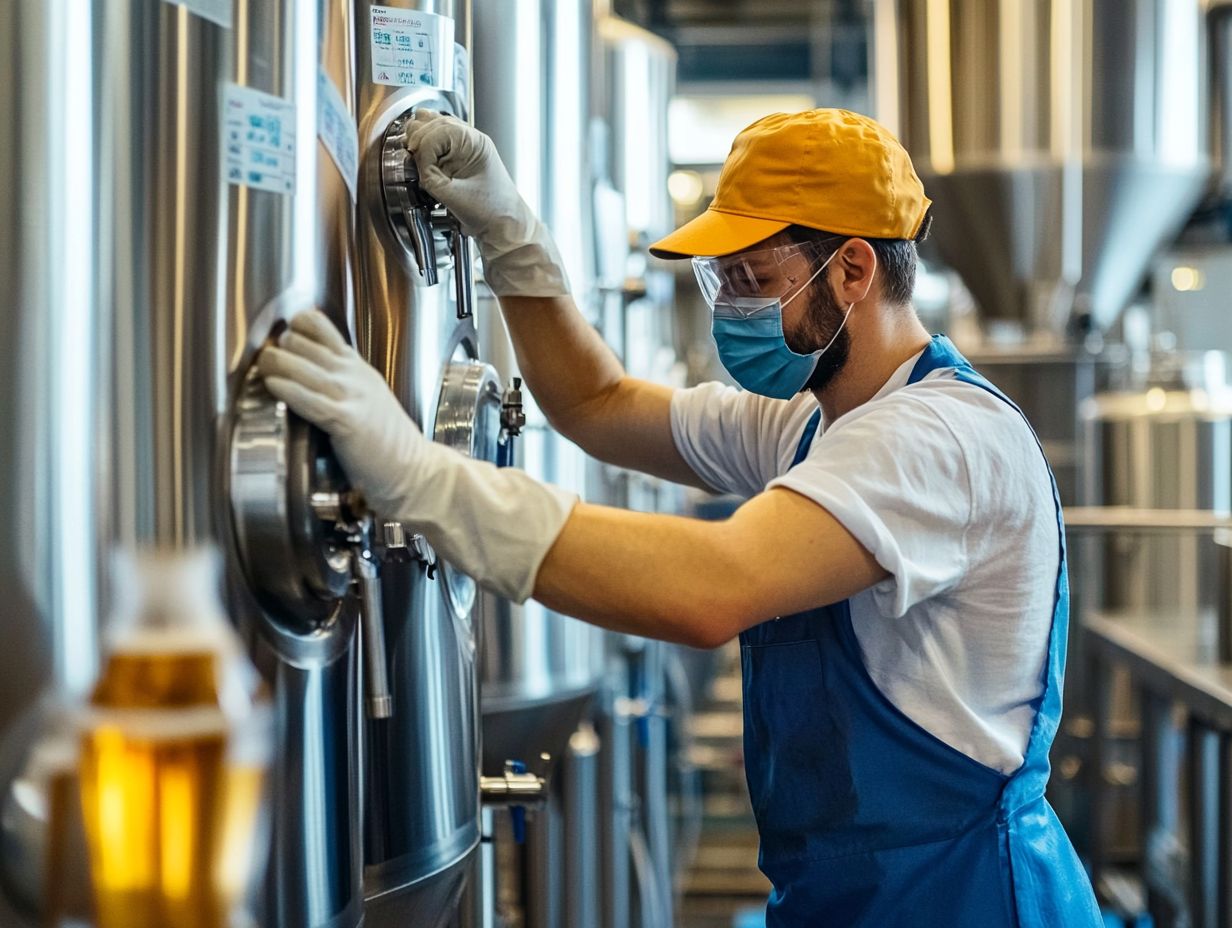
Failing to allow adequate contact time for sanitizers like Star San or Iodophor to effectively eradicate microorganisms is a common oversight. This could jeopardize the success of your sanitization process in brewing.
This crucial step is often brushed aside, leading to potential contamination and spoiled batches. Different sanitizers have specific contact times essential for maximizing their effectiveness; for example, quaternary ammonium compounds typically require around 10 minutes, while bleach solutions should remain on surfaces for at least 2 minutes. Sanitizers like Star San or Iodophor also have specific requirements that must be adhered to for effective sanitization.
In the eagerness to dive into brewing, many brewers underestimate these timings, significantly elevating the risk of unwanted bacteria or wild yeast taking hold. A rushed approach compromises not only the quality of your beer but also the integrity of the entire brewing process. Therefore, sticking to the established guidelines for optimal sanitation is paramount for ensuring success.
How Often Should Sanitization Be Performed?
In brewing, the frequency of sanitization is paramount. It guarantees that all equipment and surfaces are free from harmful microorganisms.
Adopting a structured routine for sanitization before and after each use of your brewing equipment is essential for maintaining quality and safety in your brewing process.
1. Before Each Use
Sanitizing your equipment before each use is an essential practice in brewing that dramatically minimizes the risk of contamination. It ensures a pristine environment for your craft. This step is vital for preserving the integrity of your final product; any residual bacteria or wild yeast has the potential to compromise the flavor and aroma you strive to achieve. Brewers often use sanitizers such as Star San, Iodophor, or bleach solutions for this purpose.
Pay special attention to fermenters, bottles, and any utensils involved in the brewing process. Overlooking proper sanitization can result in off-flavors, spoilage, and even health risks for consumers, underscoring the critical nature of this practice. Contaminants like Acetobacter and other harmful bacteria should be thoroughly eradicated to ensure the safety of the brew.
By establishing a routine for sanitizing, you not only protect the quality of your brew but also cultivate a reputation for safety and excellence within the brewing community.
2. After Each Use
Sanitizing your brewing equipment after each use is crucial for preventing the buildup of microorganisms and maintaining cleanliness throughout the brewing process. Products like Star San and Iodophor are commonly used for this purpose.
This practice ensures every sip is pure and delicious! It also significantly minimizes the risk of mixing harmful bacteria, which can compromise both the flavor and safety of your beverages. Every piece of equipment, from fermenters to tubes, can become a breeding ground for harmful bacteria if not cleaned properly. This could lead to spoilage and health concerns.
Breweries that emphasize a thorough sanitization routine create a hygienic environment that elevates the overall brewing experience. By prioritizing this level of care, you safeguard your investment in time and resources while fostering trust and satisfaction among consumers who expect nothing less than the highest standards in every sip.
3. Regularly During Brewing Process
Regularly sanitizing during the brewing process is a proactive strategy that you can adopt to maintain impeccable cleanliness and significantly reduce the risk of contamination at various stages of production.
This practice becomes especially vital when you’re handling raw ingredients, as they can introduce unwanted microbes into your brew. For example, before you add grains or hops, ensuring your equipment is properly sanitized can prevent mixing harmful bacteria from tools that were used previously. Using Immersion Wort Chillers can also help to rapidly cool the wort while reducing the risk of contamination.
During fermentation, it s equally important to meticulously clean airlocks and containers, as any lingering bacteria could jeopardize the integrity of your batch.
Once fermentation is complete, sanitizing bottles and kegs becomes essential to preserve flavor and extend shelf life. By incorporating sanitization at these critical points, you can confidently ensure a consistently high-quality and safe end product that meets your standards. Using sanitizers such as Star San or Iodophor at these stages is crucial.
Frequently Asked Questions
What is the importance of sanitization in brewing?
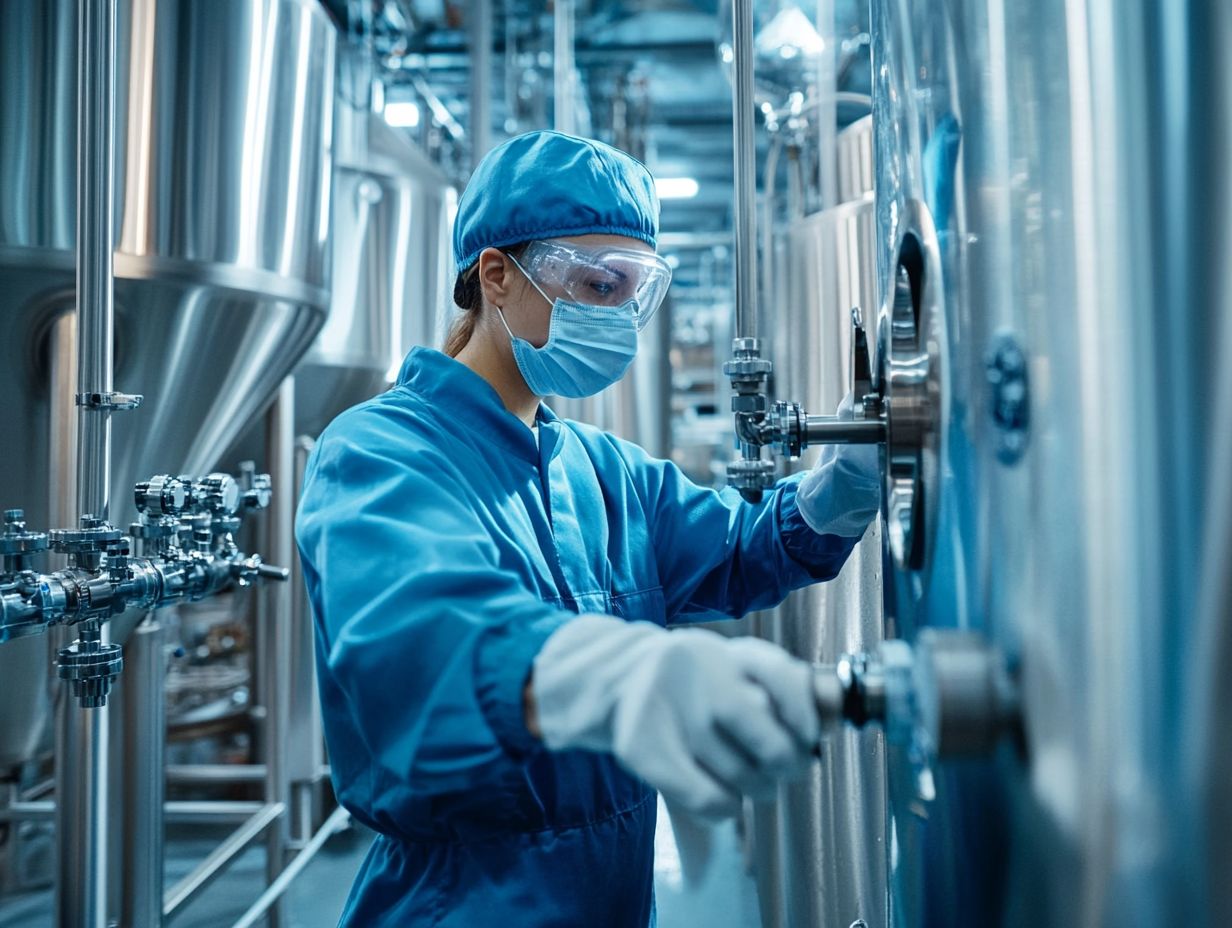
Sanitization is crucial in brewing as it ensures that harmful microorganisms are eliminated, preventing contamination and producing safe and high-quality beer. By adhering to Good Manufacturing Practices (GMP) and using effective sanitizers like Star San, brewers can maintain the integrity of their products.
What are the consequences of not properly sanitizing brewing equipment?
If brewing equipment is not sanitized properly, it can lead to off-flavors, spoilage, and even the growth of dangerous bacteria or mold in the beer. This can result in a product that is undrinkable and potentially harmful to consume. This is particularly true for bacteria such as those causing Strep Throat, Cholera, Diphtheria, or Food Poisoning.
How does sanitization impact the taste of beer?
Sanitization plays a major role in the taste of beer as it prevents unwanted bacteria and yeast from affecting the flavor. When equipment is not properly sanitized, it can result in off-flavors that can ruin the taste of the beer. Consuming beer contaminated by bacteria like Acetobacter can lead to undesirable sourness and spoilage.
Is sanitization important for both homebrewing and commercial brewing?
Yes, sanitization is important for both homebrewing and commercial brewing. Whether you are brewing in large quantities for distribution or just for personal consumption, proper sanitization is critical to producing a safe and enjoyable product. Commercial breweries like MobCraft Beer Inc. emphasize thorough sanitization to maintain high standards of quality and safety.
What are some common sanitization methods used in brewing?
Some common sanitization methods used in brewing include using sanitizing solutions like Star San and Iodophor, boiling water, and using heat or chemicals. It is important to carefully follow instructions for each method to ensure effective sanitization.
Ready to enhance your brewing process? Start implementing these sanitization practices today for quality and safety in every batch!
How often should brewing equipment be sanitized?
Ensuring your brewing equipment is cleaned properly is vital for excellent results.
Sanitizing it before and after each use removes germs and bacteria, which helps prevent unwanted issues in your final product.




